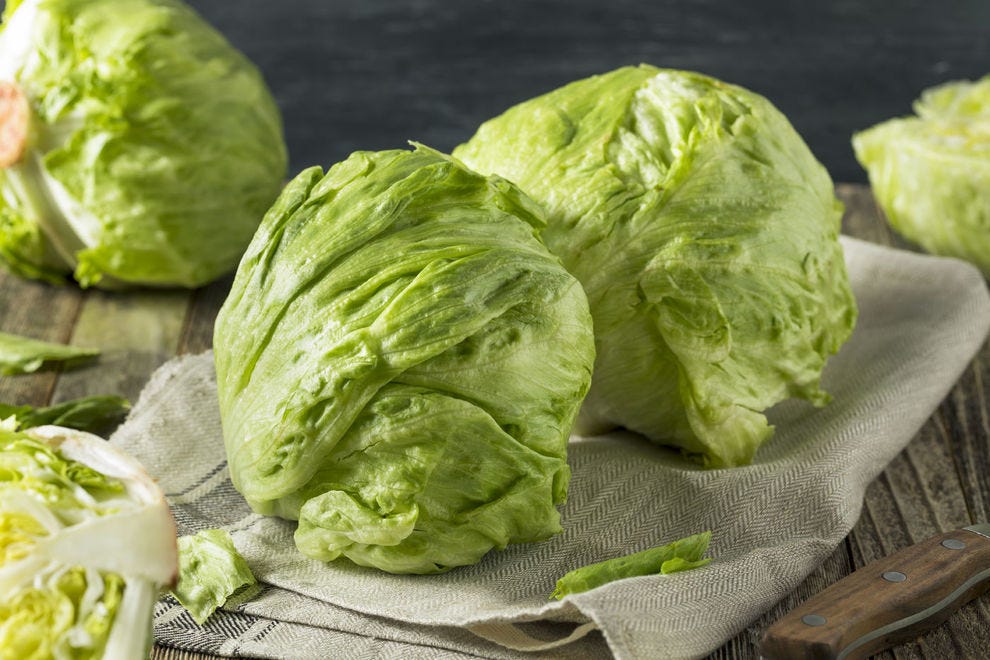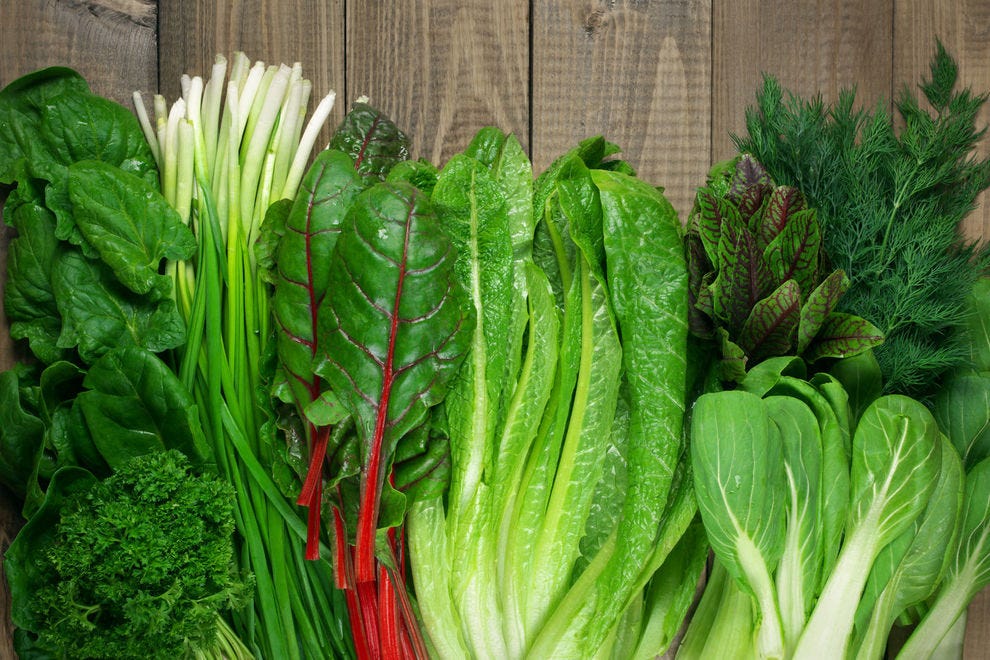An assortment of salad greens — Photo courtesy of iStock / Svetl
There are plenty of mouth-watering lettuce-free salads – such as panzanella or caprese – that we’ll gladly devour if placed before us. But when it comes time to build our own, the first thing that most of us reach for is some sort of leafy green foundation to pile high with other ingredients like fruits, croutons, proteins and, yes, vegetables.
But not all salad greens are created equal. When it comes to packing in the most nutrition and fewest calories into crisp fans, fronds and leaves, here’s how some of the most popular choices shape up:
Iceberg
10 calories per one cup serving; low in nutrients
 A crisp head of iceberg lettuce — Photo courtesy of iStock / bhofack2
A crisp head of iceberg lettuce — Photo courtesy of iStock / bhofack2
The star of one of the world’s most frequently eaten salads – the iconic wedge – is also the butt of countless culinary jokes. That’s because even when there’s a whole head of iceberg in the bowl, there’s really not that much going on.
Iceberg is sparse when it comes to both calories and nutrients. A serving of iceberg will give you just 3% of your daily vitamin C intake, 2% of iron and just a lonely 1% of calcium. Perhaps most unforgivable of all is that iceberg doesn’t really taste like much of anything.
Radicchio
9 calories per one cup serving; high levels of vitamin K
 This radicchio is ridiculously gorgeous — Photo courtesy of iStock / pilipphoto
This radicchio is ridiculously gorgeous — Photo courtesy of iStock / pilipphoto
The modelesque radicchio may not help you hit your daily recommended levels of vitamins C or E – a serving contains just 5% of each, along with 6% of folate – but at least your salad will look good, thanks to these garnet and ivory leaves.
But hey, it’s not all bad news for radicchio. A cup of it has a whopping 128% of vitamin K.
Cabbage
22 calories per one cup serving; high in vitamin C
 Cabbage takes center stage in some of our favorite sides and entrées — Photo courtesy of iStock / showcake
Cabbage takes center stage in some of our favorite sides and entrées — Photo courtesy of iStock / showcake
Cabbage – in both its scarlet and emerald forms – may not be your go-to salad green, but the thick, crunchy leaves are often shredded into slaws and boiled into stews. A serving of cabbage will only meet 9% of your daily fiber needs but a surprising 54% of vitamin C.
Cabbage doesn’t necessarily have the star power to regularly take center stage in your salad bowl, but adding some shredded leaves can add a pop of color and a satisfying crunch to an otherwise monotonous bowl of veggies.
Endive
8 calories per one cup serving; moderately high in vitamin A
 A Belgian endive, or, as it’s also known, witloof and chicory — Photo courtesy of iStock / pilipphoto
A Belgian endive, or, as it’s also known, witloof and chicory — Photo courtesy of iStock / pilipphoto
Elegant endive shells are stuffed with walnuts and apples in the classic Belgian salad, but how does the vegetable rank on its own? Pretty poorly, really. Endive’s biggest draw is likely its canoe-like shape, which makes for the perfect finger food on a tray of passed hors d’oeuvres.
Although about twice the typical serving size, a full cup contains a respectable 22% of your vitamin A needs. Things taper off quickly from there with just 6% of vitamin C and 2% of iron.
Romaine
8 calories per one cup serving; high in vitamin A
 As ripe and green a head of romaine as we could ever hope to see — Photo courtesy of iStock / wmaster890
As ripe and green a head of romaine as we could ever hope to see — Photo courtesy of iStock / wmaster890
The king of the lettuce shelves in your grocery store’s produce section, romaine is the go-to green for millions of people every single day.
Romaine puts up great vitamin A numbers (50%) and a decent dose of vitamin C (30%), but the taste of this lettuce has a tendency to turn remarkably bitter when overexposed to the sun. That bitterness is the result of farmers allowing the plant to flower.
Unfortunately for consumers, it’s nearly impossible to tell if you’re buying a head of mild, tasty, immature romaine, or an overly mature lettuce whose stalk and flowers have been removed before heading to market.
Chard
7 calories per one cup serving; high in vitamin K, magnesium and iron
 These chard leaves display a rainbow of colored stems — Photo courtesy of iStock / Teleginatania
These chard leaves display a rainbow of colored stems — Photo courtesy of iStock / Teleginatania
Though the leaves all eventually turn the same shades of green, chard is marketed under a variety of names due to the diversity of colors in the stalk of the plant. Whether you’re buying Swiss chard or Rainbow chard, the nutritional content is largely the same – which is to say, excellent.
A serving of chard will give you a whopping 250% of your vitamin K needs, the highest levels of any of the greens on our list. Respectable levels of iron and magnesium also help to oxygenate the blood and control glucose levels.
Spinach
7 calories per one cup serving; high in vitamins K, A and C
 Raw spinach offers different nutritious qualities when compared to cooked spinach — Photo courtesy of iStock / Lecic
Raw spinach offers different nutritious qualities when compared to cooked spinach — Photo courtesy of iStock / Lecic
Manganese! Folate! Iron! Plus, vitamins K, A and C. Spinach, the meaty, slightly metallic leafy green frequently paired with fruits like apples, strawberries and raspberries earns every bit of its reputation as a health-food powerhouse.
It’s a shame that an entire generation was turned off by the veggie, having grown up being forced to choke down a cooked version at the dinner table, because raw spinach is one of the best-tasting and most nutritious salad greens out there.
Kale
34 calories per one cup serving; all-around nutritious
 Raw, freshly harvested kale — Photo courtesy of iStock / Denira777
Raw, freshly harvested kale — Photo courtesy of iStock / Denira777
Don’t let the comparably high calories confuse you here; we’re still only talking about a meager 34 per serving. Kale first conquered the farmers market and then took grocery stores by storm for a good reason. It’s packed with goodies.
You want 206% of vitamin A for the day? You’ve got it. How about 134% of vitamin C? It’s yours. Your entire fill of vitamin K for the day is there in a serving as well, along with more than 2 grams of protein per cup.
